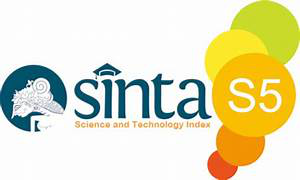MAKNA UPACARA PERKAWINAN SHINTO DI JEPANG
Abstract
A marriage ceremony is composed of rituals that are full of meaning, also decorated with clothes that are only worn at the time of marriage. This research analyzes the meaning of each ritual and dress in Shinto wedding ceremonies using Roland Barthes's Semiotic theory. Examine the connotation behind each ritual and clothing. All the rituals in the Shinto wedding ceremony have meaning as an announcement to God, relatives and friends of the bride and groom. While clothes have the meaning of showing the identity of the wearer.
Keywords : Marriage, ritual, semiotic, Shinto
References
DAFTAR PUSTAKA
Bocking, Brian. 1995. A Popular Dictionary of Shinto. London. Curzon Press.
Bremen, Jan van. 1995. Ceremony and Ritual in Japan. London. Routledge
Buckley, Sandra. 2002. Encyclopedia of Contemporary Japanese Culture. New York. Routledge
Christomy, T ed. 2004. Semiotik Budaya. Depok. Pusat Penelitian Kemasyarakatan dan Budaya Direktorat Riset dan Pengabdian Masyarakat Universitas Indonesia.
Edwards, Walter. 1989. Modern Japan Through Its Wedding (Gender, Person, and Society in Ritual Portrayal). California. Standford University Press.
Fox, James. 1999. Religion and ritual. Singapore. Archipelago Press.
Gendai Mana Foramu. 1996. E de Wakaru Mana Jiten. Tokyo. Seitosha.
George A.,Cobbold B.A. 2009. Religion in Japan. The Project Gutenberg EBook
Hartz, Paula R. 2009. World Religions Shinto Third Edition. New York. Chelsea House Publishers.
Hoed, Benny. H. 2011. Semiotik dan Dinamika Sosial Budaya. Depok. Komunitas
Bambu.
Ichida, Hiromi & Tsukamoto Koichi. 1990. Saishinhan Kekkon Hyakka : Dento no Shikitari to Atarashii Iwaikata. Japan. Kodansha
Ichijo, Shinya & Zou Jimusho. 2008. Kaiun! Pawaasupotto (Jinja) e Ikoo. Japan. PHP Kenkyujo
Kamachi, Noriko. 1999. Culture and Customs of Japan. Amerika. Greenwood
Press.
Kanaya, Chizuko. 2002. Musume, Musuko no Kekkon, Oya no Yakuwari Manaa. Tokyo.
Kitajima, Hirotoshi. 2012. Kanarazu Dareka ni Hanashitakunaru : Migi†to Hidari†no Omoshiro Neta Jiten. Japan. PHP Kenkyujo
Masaki, Akira & Nakao Isako. 2007. Zatsugaku Sanbunkan Bijuaru Zukai Shirizu : Yoku Wakaru Jinja Jingu. Japan. PHP Kenkyujo
Seikatsu Bunka Henshubu. 1994. Encyclopedia of Daily Life : Seikatsu Kihon Daihyakka. Japan. Shueisha.
Shufu to Seikatsusha. 1988. Hitomede Wakaru Kankonsosai no Chishiki Hyakka. Japan. Shufu to Seikatsusha.
_________________. 1991. Seikatsu no Shikitari kara Otsukiai no Sakuho made Nihonjin no Kimarigoto Jiten. Shufu to Seikatsusha.
Sumitomo, Yoshie. Ketteihan Issho Tsukaeru! Kankonsosai no Mana. Japan. PHP Kenkyujo.
Tame, Joseph. 2006. The Chapel Wedding Industry in Japan. (Undergraduate project as a part of a BA in Japanese Studies at the University of Sheffield).
Tokuhiro, Yoko. 2010. Marriage in Contemporary Japan. New York. Routledge.
Williams, George. 2005. Religion of The World : Shinto. Amerika. Chelsea House Publishers
Jurnal
Edwards, Walter. 1987. The Commercialized Wedding as Ritual: a Window on Social Values. Journal of Japanese Studies, 13.1. pp 51-78. http://www.jstor.org/stable/132586
Goldstein-Gidoni, Ofra. 2001. Hybridity and Distinctions in Japanese Contemporary Commercial Weddings. Social Science Japan Journal Vol.4, No.1. pp 21-38. http://www.jstor.org/stable/30209651.
Goldstein-Gidoni, Ofra. 1999. Kimono and the Construction of Gendered and Cultural Identities.Ethnology, Vol. 38, No. 4 (Autumn, 1999), pp. 351-370. http://www.jstor.org/stable/3773912.
Fisch, Michael. 2001. The Rise of The Chapel Wedding in Japan (Simulation and Performance). Japanese Journal of Religious Studies vol. 28 No. 1-2 pp.57-76. http://www.jstor.org/stable/30233676.
Staff of RCRD. 1966. Shinto Symbols. Contemporary Religions in Japan, Vol. 7, No. 1 (Maret, 1966), pp. 3-39. http://www.jstor.org/stable/30232983.
Staff of RCRD. 1966. Shinto Symbols (Continued). Contemporary Religions in Japan, Vol. 7, No. 2 (Juni, 1966) pp. 89-142. http://www.jstor.org/stable/30232989.
Sumber data :
http://www.youtube.com/watch?v=vuaqMf2VoO8
DOI: 10.33751/wahana.v26i1.2102
Refbacks
- There are currently no refbacks.













